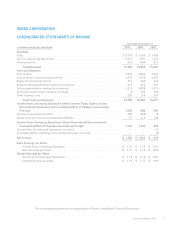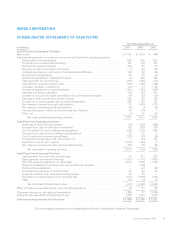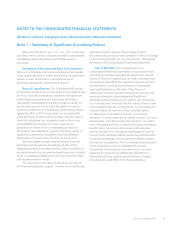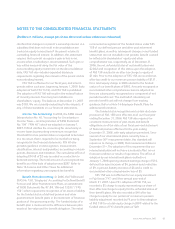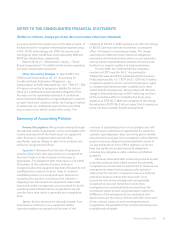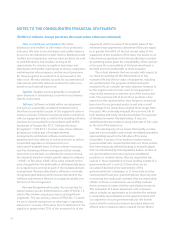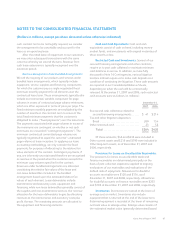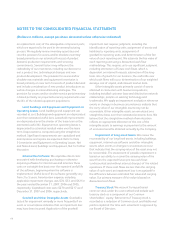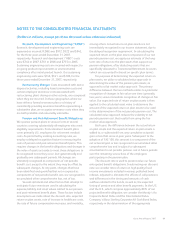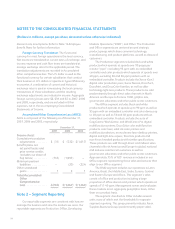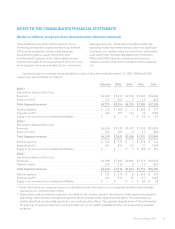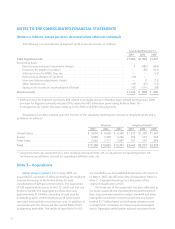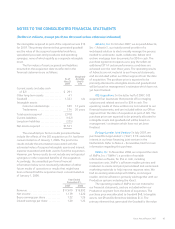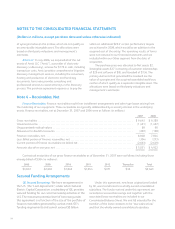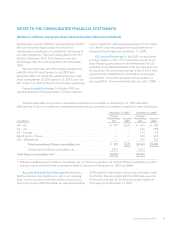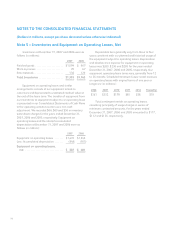Xerox 2007 Annual Report Download - page 88
Download and view the complete annual report
Please find page 88 of the 2007 Xerox annual report below. You can navigate through the pages in the report by either clicking on the pages listed below, or by using the keyword search tool below to find specific information within the annual report.NOTES TO THE CONSOLIDATED FINANCIAL STATEMENTS
(Dollars in millions, except per-share data and unless otherwise indicated)
Sales to distributors and resellers: We utilize
distributors and resellers to sell certain of our products to
end-users. We refer to our distributor and reseller network
as our two-tier distribution model. Sales to distributors and
resellers are recognized as revenue when products are sold
to such distributors and resellers, as long as all
requirements for revenue recognition have been met.
Distributors and resellers participate in various cooperative
marketing and other programs, and we record provisions
for these programs as a reduction to revenue when the
sales occur. We also similarly account for our estimates of
sales returns and other allowances when the sales occur
based on our historical experience.
Supplies: Supplies revenue generally is recognized
upon shipment or utilization by customers in accordance
with the sales terms.
Software: Software included within our equipment
and services is generally considered incidental and is
therefore accounted for as part of the equipment sales or
services revenues. Software accessories sold in connection
with our equipment sales as well as free-standing software
revenues are accounted for in accordance with AICPA
Statement of Position No. 97-2, “Software Revenue
Recognition” (“SOP 97-2”). In most cases, these software
products are sold as part of multiple element
arrangements and include software maintenance
agreements for the delivery of technical service as well as
unspecified upgrades or enhancements on a
when-and-if-available basis. In those software accessory
and free-standing software arrangements that include
more than one element, we allocate the revenue among
the elements based on vendor-specific objective evidence
(“VSOE”) of fair value. VSOE of fair value is based on the
price charged when the deliverable is sold separately by us
on a regular basis and not as part of the multiple-element
arrangement. Revenue allocated to software is normally
recognized upon delivery while revenue allocated to the
software maintenance element is recognized ratably over
the term of the arrangement.
Revenue Recognition for Leases: Our accounting for
leases involves specific determinations under SFAS No. 13,
which often involve complex provisions and significant
judgments. The two primary criteria of SFAS No. 13 which
we use to classify transactions as sales-type or operating
leases are 1) a review of the lease term to determine if it is
equal to or greater than 75% of the economic life of the
equipment and 2) a review of the present value of the
minimum lease payments to determine if they are equal
to or greater than 90% of the fair market value of the
equipment at the inception of the lease. Our leases in our
Latin America operations have historically been recorded
as operating leases given the cancellability of the contract
or because the recoverability of the lease investment is
deemed not to be predictable at lease inception.
The critical elements that we consider with respect to
our lease accounting are the determination of the
economic life and the fair value of equipment, including
the residual value. For purposes of determining the
economic life, we consider the most objective measure to
be the original contract term, since most equipment is
returned by lessees at or near the end of the contracted
term. The economic life of most of our products is five
years since this represents the most frequent contractual
lease term for our principal products and only a small
percentage of our leases have original terms longer than
five years. We continually evaluate the economic life of
both existing and newly introduced products for purposes
of this determination. Residual values, if any, are
established at lease inception using estimates of fair value
at the end of the lease term.
The vast majority of our leases that qualify as sales-
type are non-cancelable and include cancellation penalties
approximately equal to the full value of the lease
receivables. A portion of our business involves sales to
governmental units. Governmental units are those entities
that have statutorily defined funding or annual budgets
that are determined by their legislative bodies. Certain of
our governmental contracts may have cancellation
provisions or renewal clauses that are required by law,
such as 1) those dependant on fiscal funding outside of a
governmental unit’s control, 2) those that can be
cancelled if deemed in the best interest of the
governmental unit’s taxpayers or 3) those that must be
renewed each fiscal year, given limitations that may exist
on entering into multi-year contracts that are imposed by
statute. In these circumstances, we carefully evaluate
these contracts to assess whether cancellation is remote.
The evaluation of a lease agreement with a renewal
option includes an assessment as to whether the renewal
is reasonably assured based on the apparent intent and
our experience of such governmental unit. We further
ensure that the contract provisions described above are
offered only in instances where required by law. Where
86



